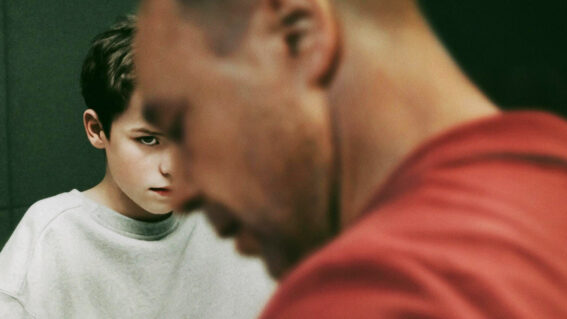How unassuming bear Paddington became a joyous global smash

Paddington is back after seven years in a new cinematic adventure, which prompts Amelia Berry to examine his big screen rise to Citizen Kane-besting heights.
Red hat. Blue coat. Marmalade sandwich. Paddington Brown—the bear from Darkest Peru—has spent the last decade or so taking the world of family cinema by storm. He’s won critic’s awards, he’s ousted Citizen Kane as the highest-rated film on Rotten Tomatoes, and just this November he’s been breaking British and Irish box office records.
But just what is it that makes this iteration of Paddington—the CGI Ben Whishaw version—such a global smash?
Well, oddly, the story begins with a 2009 surreal comedy film about a debauched roadtrip through Europe—Bunny and the Bull. The debut feature from writer/director Paul King, King had cut his teeth working on cult British TV comedies Garth Marengi’s Darkplace and The Mighty Boosh.
Bunny and the Bull certainly has elements of The Mighty Boosh—the strange, handmade world, the use of retro film tricks like back projection, the dark delirious tone. But it also shows a bold creative ambition, pushing for a more sensitive, sentimental angle on gonzo grotesqueries of Jeunet & Caro or Terry Gilliam.
It grossed $81,010 worldwide.
But. One of the few people who did see Bunny and the Bull was Harry Potter super-producer David Heyman. With the film rights to Paddington Bear already in hand, Heyman saw something in King’s strange and melancholic film that he found striking.
“[Paul King] knew more about Paddington, when I met him, than anybody—he knew more than I did,” Heyman said to Den of Geek in 2017, “His Bunny and the Bull had visual flare (sic), his humour in The Mighty Boosh was subversive, and it was very important to me that the humour appealed to adults and not just children.”
Heyman made King a low-pressure offer—go away, write a couple of takes on Paddington, if we don’t find one we’re all happy with, we won’t bother. So, drawing mainly from Michael Bond’s original Paddington books and the 1976 stop-motion Paddington Bear TV series, Paul King gave it a shot. The result is 2014’s elegantly titled Paddington.
The first really important thing about the original Paddington is that Paddington himself looks—frankly—beautiful. Like if a best-in-show cat was also your favourite nephew. Created by UK effects house Framestore using fur tech pioneered on a rather different talking bear film, The Golden Compass (2007), Paddington is a miracle of effort, taking 350 artists two and a half years to animate.
King’s story splits the difference between traditional Paddington—domestic, small-scale, sentimental—and the more bombastic action-adventure feel of modern blockbuster children’s films. Paddington arrives in London and is taken in by the Brown family (led with wonderful performances by Hugh Bonneville and Sally Hawkins), but after feeling like he doesn’t fit in, he goes searching for a new home, only to find himself in the clutches of Evil Taxidermist (and owner of inexplicable spy tech) Millicent Clyde (Nicole Kidman).
Despite its densely packed script, delightful set pieces, and astonishing knack for slapstick (King apparently heavily referenced Chaplin’s The Kid)—Paddington does sometimes feel a little unsure of how to marry its two modes. Born to be a touching parable about being accepting to outsiders. Forced to be Spy Kids UK.
But with the first Paddington proving a breakthrough box office success, King approached 2017’s Paddington 2 with a new surety and vision.
With Hugh Grant now as the villain—unscrupulous thespian and master of disguise Phoenix Buchanan—Paddington is framed and sent to prison (!!!) where he has to learn to get along with fellow inmate Knuckles McGinty (Brendan Gleeson) or face a life of misery and gruel.
Adding Simon Farnaby (Horrible Histories but also also of Bunny and the Bull) on co-writer duties, Paddington 2 eschews the more OTT American aspects of the first film—leaning more heavily on retro British influences like Chitty Chitty Bang Bang, Wallace & Gromit, and a definite whiff of panto.

It’s something about this difficult-to-define ‘classic’ quality that makes Paddington 2 such a peculiarly brilliant and moving (some might say “Citizen Kane level”) film.
Like a vintage murder mystery, it brings together a grab-bag of resonant archetypes—fortune tellers, train cars, gruff prisoners, cryptic coded clues. Like a Roald Dahl story, the characters in Paddington 2 are in real danger of real death from really bad people. And unlike so much of the glib, self-aware children’s media we’ve seen in recent decades, Paddington 2 is serious about the transformative power of kindness, curiosity, and love.
And if that sounds corny to you, well… you might need to open your heart. And rewatch Paddington 2.

So, after a journey like that, leading you to a basically perfect film in Paddington 2—where do you go? Well, Paul King, Simon Farnaby, and Sally Hawkins chose to leave on a high, bowing out of Paddington to work on Wonka (2023). But the show must go on, and directorial duties for the next Paddington were handed to Dougal Wilson (his debut feature, although you’ll know his work from the Benny Benassi Satisfaction music video).
Now, seven years later, we finally have a new film: Paddington in Peru. Paddington and the Browns must voyage into the deepest jungles of Darkest Peru after they receive a distressing message about Paddington’s dear Aunt Lucy.
And is it good? Well, it’s all relative, isn’t it. Compared to the average CGI-heavy children’s film it’s a barn burner, with brilliant comic performances from Antonio Banderas as a slightly mad riverboat captain and Olivia Colman as a nun who can’t decide whether she’s in The Sound of Music or Black Narcissus. It hits all the notes and running gags you expect from a Paddington film, and if it’s the last one? Well, it’s a decent note to go out on.
Next to Paddington 2 though? Neither the script nor the set design are anywhere near as dense. The tightly woven set-up and pay-off from the previous two films feels flimsy and rushed here. And where Paddington 2’s treatment of prisons felt knowing and subversive, Paddington in Peru never feels fully committed in its relationship with exoticism and colonialism. In just about every way, this third entry feels like… less Paddington.
But if Paddington in Peru is formulaic (and it is)—the Paddington formula is just so charming. Ben Whishaw still turns in a heartfelt and funny vocal performance, the gags are creative and memorable, and the story will still make you cry. Some might find it sacrilegious to carry on the franchise with so many of the key creative talents missing, but really… so long as it’s only one more marmalade sandwich, it surely won’t do any harm. Right?


























